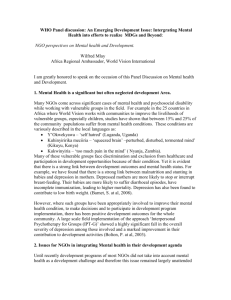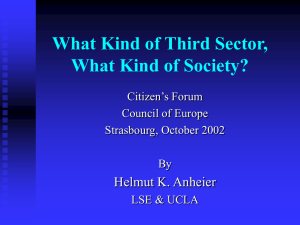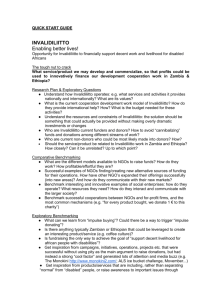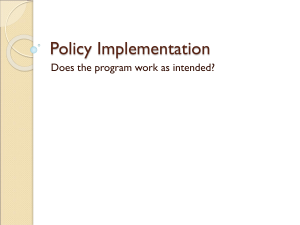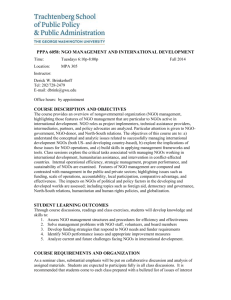text
advertisement
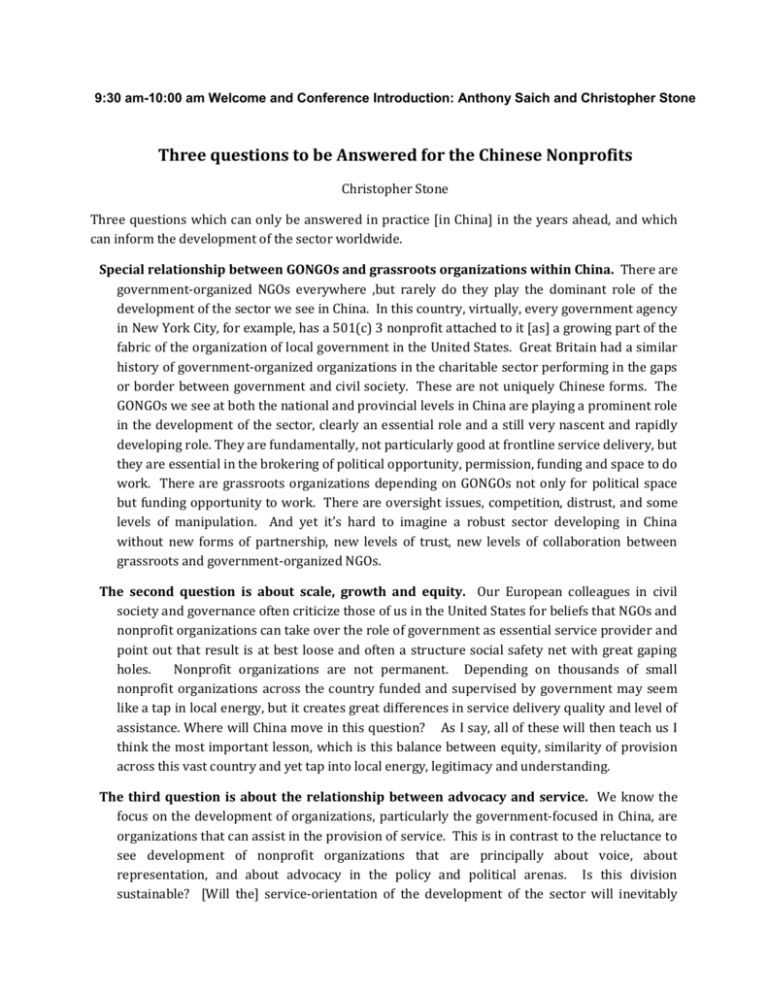
9:30 am-10:00 am Welcome and Conference Introduction: Anthony Saich and Christopher Stone Three questions to be Answered for the Chinese Nonprofits Christopher Stone Three questions which can only be answered in practice [in China] in the years ahead, and which can inform the development of the sector worldwide. Special relationship between GONGOs and grassroots organizations within China. There are government-organized NGOs everywhere ,but rarely do they play the dominant role of the development of the sector we see in China. In this country, virtually, every government agency in New York City, for example, has a 501(c) 3 nonprofit attached to it [as] a growing part of the fabric of the organization of local government in the United States. Great Britain had a similar history of government-organized organizations in the charitable sector performing in the gaps or border between government and civil society. These are not uniquely Chinese forms. The GONGOs we see at both the national and provincial levels in China are playing a prominent role in the development of the sector, clearly an essential role and a still very nascent and rapidly developing role. They are fundamentally, not particularly good at frontline service delivery, but they are essential in the brokering of political opportunity, permission, funding and space to do work. There are grassroots organizations depending on GONGOs not only for political space but funding opportunity to work. There are oversight issues, competition, distrust, and some levels of manipulation. And yet it’s hard to imagine a robust sector developing in China without new forms of partnership, new levels of trust, new levels of collaboration between grassroots and government-organized NGOs. The second question is about scale, growth and equity. Our European colleagues in civil society and governance often criticize those of us in the United States for beliefs that NGOs and nonprofit organizations can take over the role of government as essential service provider and point out that result is at best loose and often a structure social safety net with great gaping holes. Nonprofit organizations are not permanent. Depending on thousands of small nonprofit organizations across the country funded and supervised by government may seem like a tap in local energy, but it creates great differences in service delivery quality and level of assistance. Where will China move in this question? As I say, all of these will then teach us I think the most important lesson, which is this balance between equity, similarity of provision across this vast country and yet tap into local energy, legitimacy and understanding. The third question is about the relationship between advocacy and service. We know the focus on the development of organizations, particularly the government-focused in China, are organizations that can assist in the provision of service. This is in contrast to the reluctance to see development of nonprofit organizations that are principally about voice, about representation, and about advocacy in the policy and political arenas. Is this division sustainable? [Will the] service-orientation of the development of the sector will inevitably move organizations into a role of representing and speaking for and giving voice to those they provide service. The relationship between advocacy and service is going to develop in China inevitably in ways we haven’t seen elsewhere and understanding that and following it empirically as well as theoretically is one of the tasks ahead. Making Sense of the Contradicting Observations about Chinese Civil Society Anthony Saich Recently we witnessed diverse interpretations about the state of civil society in China and the possibilities for its future directions. There is no doubt the field is booming. Yet at the same time, there has been concern at the closing down of organizations that are seen to be too strident in defending the interests of their communities and especially those that are seen to have a foreign connection. These two trends reflect the ambivalence of the Chinese authorities that recognizes government alone cannot provide sufficient services to their people yet at the same time does not trust organizations they feel may operate outside of their control. A number of people say the legislation coming in is controlling and problematic. I actually think it could be positive. Over time, more precise regulation might allow the sector to develop more effectively. ...The desire through legislation is to replicate the Leninist compartmentalization that features in other organizational areas. The Chinese leadership is slowly moving towards trusting most of its domestic organizations, and there is much evidence from localities of de facto government-public partnerships. Policy seems geared to protecting those organizations while eradicating those that may push sectoral or political interests. With China’s growing wealth, I think its leaders have decided that there is less need for foreign NGOs and engagement, which it inevitably feels is less trustworthy and may have other motives for engagement. Essentially, the organization becomes an arm of the government, carrying out the latter’s objectives. Public Welfare Donations Law …favors those large organizations with senior ex-officials in leadership positions over grass-roots organizations. Presumably, this is intentional, as the central government has been consistently concerned that tax relief for donations to NGOs could result either in money laundering or in a reduction in the funds available for its own coffers. Also, given the difficult financial circumstances of a large number of local authorities, many are likely to resist tax reductions unless it is for an organization with powerful local connections. [The rise of NGOs] is similar to that elsewhere in the world. During the reform period, local governments have been experimenting with service delivery through a variety of mechanisms. Most governments have insufficient funds to extend services as much as they would like or to subsidize the welfare programs that they wish to support. Secondly, whether true or not, there seems to be a popular perception that publicly provided services are more embroiled in bureaucracy, are of lower quality, and are liable to be mired in corruption. Clearly, to improve the quality of service provision, government will have to make more effective use of both the market and not-for-profit-organizations. Service provision is the easiest area for the party to accept a role for civil society and nonprofits. Government performance will come under greater assessment about its ability to manage effectively partnerships with for-profit and not-for-profit organizations rather than on its ability to provide fund and service. [In cities,] Shiye danwei, public service units, are slowly to be privatized. To some extent, they begin to compete in the same place with other not-for-profit organizations. In rural China, community-based organizations are expanding in number and it is clear that alternatives are emerging to take over functions that were previously considered the preserve of government. Many of those organizations are based on traditional associations such as temples or social networks, including clans and lineages.


